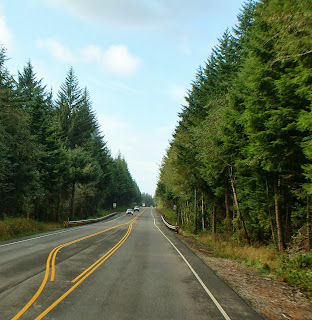One of the first impressions you get when you drive down the Avenue of the Giants is how much light is intercepted by the huge crowns. It was an extremely bright and sunshiny day, but only a few flecks of light made it to the ground.
Next to our RV park was this big specimen known as "The Eternal Tree". For many of these trees, this is not a misleading name. Often, when large trees fall, they are replaced by smaller trees that sprout from the roots of their forerunner. One could consider this as truly immortal protoplasm. This tree is approximately 950 years old, and has survived numerous disasters. Repeated lightening strikes have removed nearly 50 feet of its once nearly 400 foot height. The axe on the side marks the high water mark of the 1964 flood. These trees are in the flood plain of the nearby Eel River.
The area between Ted's fingers mark over 100 years of growth. This was one of the smaller logs in the area.
The hole left when this tree fell was at least 10 feet deep, even though there has obviously been a great deal of soil washed into it.
This was one of the taller trees in the nearby Rockefeller Grove. It is at least 120 feet to the first branch.
Even the galls are impressive. This one is, at least, four feet wide at its widest point and around 8 feet from top to bottom.
It is impossible to give a true appreciation for the size of these marvelous organisms. Ted's five foot ten inch height seems almost out of place here.
This snag and the red cast of the dead foliage lends a cathedral-like feeling to this forest. When you hear people speak, it is always in hushed tones. This only adds to the worshipful ambiance.
How long did this tree live before it fell? How long ago was that? Time seems immaterial.
We have both read Fall of the Giants, and, although it has nothing to do with the redwoods, somehow, that title seems to fit here. The smallest of these logs was at least seven feet in diameter. Perhaps this was a chain reaction in which one tree fell into others causing them to fall. They were cut only to make a path through them. Superlatives seem woefully inadequate.
This little fellow seems to predict a long winter as he crawls between the red feather-like redwood foliage. The passage of seasons matters more here than the passage of years.
As we were walking through the woods, we met an attractive young couple walking on the same path. They were kind enough to allow us to take a photograph of their cute baby, who seemed perfectly content sitting in the lap of this giant. There is only an age difference of a millennium or two.
This gives some perspective, doesn't it?
By the way, thank you again for letting us put your baby on our blog and especially for your service HOOAH!!





















































